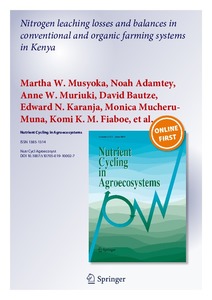| dc.contributor.author | Musyoka, M.W. |
| dc.contributor.author | Adamtey, N. |
| dc.contributor.author | Muriuki, A.W. |
| dc.contributor.author | Bautze, D. |
| dc.contributor.author | Karanja, E.N. |
| dc.contributor.author | Mucheru-Muna, M. |
| dc.contributor.author | Fiaboe, K. |
| dc.contributor.author | Cadisch, G. |
| dc.date.accessioned | 2019-12-04T11:33:58Z |
| dc.date.available | 2019-12-04T11:33:58Z |
| dc.date.issued | 2019-06-01 |
| dc.identifier.citation | Musyoka, M.W., Adamtey, N., Muriuki, A.W., Bautze, D., Karanja, E.N., Mucheru-Muna, M., ... & Cadisch, G. (2019). Nitrogen leaching losses and balances in conventional and organic farming systems in Kenya. Nutrient Cycling in Agroecosystems, 1-24. |
| dc.identifier.issn | 1385-1314 |
| dc.identifier.uri | https://hdl.handle.net/20.500.12478/5856 |
| dc.description.abstract | Organic farming has been proposed as a solution to foster agricultural sustainability and mitigate the negative environmental impacts of conventional farming. This study assessed N losses and soil surface N balances in conventional and organic farming systems in a sub-humid and semi-humid (Chuka and Thika) sites in Kenya. Nitrate–N (NO3−–N) leached was trapped at 1 m depth using the Self Integrating Accumulator core method and the changes in mineral-N were assessed at different soil depths and different crop growth stages. Both conventional and organic farming systems lost substantial amounts of NO3−–N at the early growth stages of all the crops. Cumulative NO3−–N leached was similar in all the farming systems in each cropping season. More NO3−–N was leached during potato cropping (22–38 kg N ha−1) than during maize (0.9–5.7 kg N ha−1) and vegetable cropping (1.9–2.9 kg N ha−1). Under maize cultivation, three times more NO3−–N was leached at Chuka site than at Thika site. During the potato cropping, between 79 and 83% of the N applied in the low input systems was leached, compared to 10–20% in the high input systems. Only Org-High exhibited a positive soil surface N balance (797–1263 kg ha−1) over a whole rotation period at both sites. We recommend reducing N applications for potato in all farming systems and at the early growth stages for all the crops in order to reduce N loss to the environment. We also recommend increasing N application rates in the low input systems and to developing a model to guide application of organic inputs. |
| dc.description.sponsorship | Biovision Foundation |
| dc.description.sponsorship | Swiss Coop Sustainability Fund, Liechtenstein Development Service |
| dc.description.sponsorship | Swiss Agency for Development and Cooperation |
| dc.description.sponsorship | International Centre of Insect Physiology and Ecology |
| dc.description.sponsorship | Swedish International Development Cooperation Agency |
| dc.format.extent | 1-24 |
| dc.language.iso | en |
| dc.rights | Copyrighted; all rights reserved |
| dc.subject | Farming Systems |
| dc.subject | Low Input Farming |
| dc.subject | Data Collection |
| dc.subject | Rain |
| dc.subject | Organic Farming |
| dc.title | Nitrogen leaching losses and balances in conventional and organic farming systems in Kenya |
| dc.type | Journal Article |
| dc.description.version | Peer Review |
| cg.contributor.affiliation | University of Hohenheim |
| cg.contributor.affiliation | Research Institute of Organic Agriculture |
| cg.contributor.affiliation | Kenya Agricultural and Livestock Research Organization |
| cg.contributor.affiliation | International Centre of Insect Physiology and Ecology |
| cg.contributor.affiliation | Kenyatta University |
| cg.contributor.affiliation | International Institute of Tropical Agriculture |
| cg.coverage.region | Africa |
| cg.coverage.region | East Africa |
| cg.coverage.country | Kenya |
| cg.isijournal | ISI Journal |
| cg.authorship.types | CGIAR and developing country institute |
| cg.iitasubject | Farming Systems |
| cg.journal | Nutrient Cycling in Agroecosystems |
| cg.howpublished | Formally Published |
| cg.accessibilitystatus | Limited Access |
| local.dspaceid | 105577 |
| cg.targetaudience | Scientists |
| cg.identifier.doi | https://dx.doi.org/10.1007/s10705-019-10002-7 |

